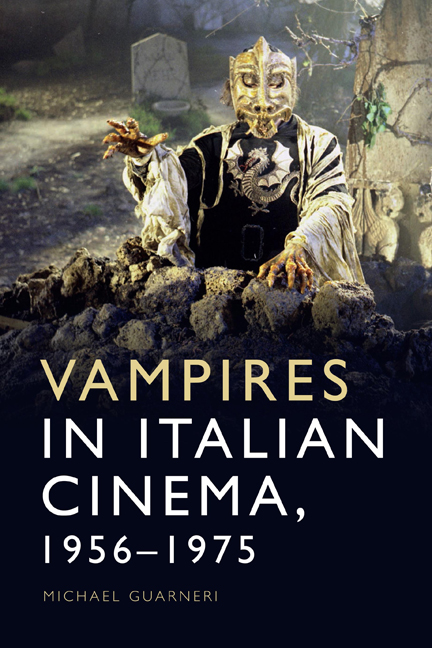Book contents
- Frontmatter
- Contents
- Figures and tables
- Acknowledgements
- Introduction
- PART I THE INDUSTRIAL CONTEXT
- PART II VAMPIRE SEX AND VAMPIRE GENDER
- PART III SANGUINE ECONOMY, BLOODY POLITIC
- Appendix A Three Italian vampire films that were never made
- Appendix B Files from the Italian Show Business Bureau fonds at the Archivio Centrale dello Stato in Rome
- Bibliography
- Index
Appendix A - Three Italian vampire films that were never made
Published online by Cambridge University Press: 10 October 2020
- Frontmatter
- Contents
- Figures and tables
- Acknowledgements
- Introduction
- PART I THE INDUSTRIAL CONTEXT
- PART II VAMPIRE SEX AND VAMPIRE GENDER
- PART III SANGUINE ECONOMY, BLOODY POLITIC
- Appendix A Three Italian vampire films that were never made
- Appendix B Files from the Italian Show Business Bureau fonds at the Archivio Centrale dello Stato in Rome
- Bibliography
- Index
Summary
IL TESCHIO DEL VAMPIRO (1962)
In November 1962 Italian production company CA. PO. MA. Film – cofounded by Alberto Cardone (assistant director on the set of Roger Vadim's Il sangue e la rosa) and Marco Masi (perhaps the same ‘M. Masi’ who wrote a few horror fotoromanzi of the 1961–1967 Malìa series) – submitted to the Italian Show Business Bureau the screenplay, the estimated budget and the financial plan for a vampire horror titled Il teschio del vampiro (‘The skull of the vampire’). Based on a screenplay by Cardone and Masi, Il teschio del vampiro was to be shot under the direction of Cardone in twenty-four days. The estimated budget was 59.3 million lire, one-third of which consisted of the Italian distributor's minimo garantito. The government officials enacting preventive censorship summarised the plot as follows.
Because of a rainstorm, five young people – Franco, Paola, Riccardo, Antonella and Luciano – take shelter in an old church in the [Italian] countryside. During the night, Luciano falls into a hole full of skulls. Among them, there is the skull of a vampire. Luciano does not say anything to his friends but, when he later goes back to the hole, the skull of the vampire has disappeared. Luciano discovers that he has two marks on his neck and believes that he has been vampirised. Upon their return to the Black Cat Inn, Franco, Paola, Riccardo, Antonella and Luciano talk about the old church and are baffled by the reaction of Rosetta (a chambermaid) and Maria and Giulio (the owners of the inn). Menica, an old woman from a nearby village, explains why everybody at the inn is afraid of the old church. Luciano is impressed by Menica's explanation and, due to telaesthetic [sic] phenomena, he becomes convinced that he is the perpetrator of the crimes that the actual victim of the vampire is committing. It is only at the end of the film that Antonella tells Luciano the truth. At first, Luciano does not believe her, then he understands everything and destroys the skull of the vampire in order to free Antonella from the monster. However, by destroying the vampire of the old church, Luciano has also put an end to Antonella's life. The young man takes the dying girl in his arms.
- Type
- Chapter
- Information
- Vampires in Italian Cinema, 1956-1975 , pp. 173 - 176Publisher: Edinburgh University PressPrint publication year: 2020



